

|
| DEUTSCHLAND | GERMANY |
| Bundesland: Mecklenburg-Vorpommern | Mecklenburg-West Pomerania |
| Hansestadt: Rostock |
 Rostock is situated at the river Warnow close to its estuary into the Baltic sea.
About 1,400 years ago Slavic settlers founded a village which became known as Roztoc.
The first mention in a document dates from 1161. German settlers gradually replaced the Slavic population around 1200.
Already in 1218 the status of Rostock as a town was confirmed.
During the following century the dukes of Mecklenburg lost much of their control over the city.
Rostock acquired the woodlands of the Rostocker Heide in 1252, obtained the right to mint coins in 1325, and gained the right of full jurisdiction in 1358.
In 1265 three separate parts of the town had been joined, and in 1325 Rostock had purchased the fishing village of Warnemünde.
During the 14th and 15th centuries, Rostock was an important member of the Hanse federation of trading towns.
The university of Rostock was founded in 1419, and thus is the oldest university in the Baltic Sea area.
At the end of the 15th century, however, the dukes of Mecklenburg could regain the control over the city.
After repeated occupations and devastations during the Thirty Years' War (1618–1648) Rostock lost much of its importance.
Only during the 19th century, the city began to expand again. After the first steel steamship had been built at Rostock in 1852,
the Neptun shipyards, founded in 1891, became the first large industrial company of Mecklenburg.
After World War I aviation industry became an important factor with the foundation of the
Heinkel and Arado works in 1923/25. After 1933, Rostock became the centre of the German arm industry. Large parts of the
town were destroyed by allied bomb raids in 1942. After the re-unification of Germany in 1990, the prefix 'Hansestadt' was again added to the city's name.
Rostock is situated at the river Warnow close to its estuary into the Baltic sea.
About 1,400 years ago Slavic settlers founded a village which became known as Roztoc.
The first mention in a document dates from 1161. German settlers gradually replaced the Slavic population around 1200.
Already in 1218 the status of Rostock as a town was confirmed.
During the following century the dukes of Mecklenburg lost much of their control over the city.
Rostock acquired the woodlands of the Rostocker Heide in 1252, obtained the right to mint coins in 1325, and gained the right of full jurisdiction in 1358.
In 1265 three separate parts of the town had been joined, and in 1325 Rostock had purchased the fishing village of Warnemünde.
During the 14th and 15th centuries, Rostock was an important member of the Hanse federation of trading towns.
The university of Rostock was founded in 1419, and thus is the oldest university in the Baltic Sea area.
At the end of the 15th century, however, the dukes of Mecklenburg could regain the control over the city.
After repeated occupations and devastations during the Thirty Years' War (1618–1648) Rostock lost much of its importance.
Only during the 19th century, the city began to expand again. After the first steel steamship had been built at Rostock in 1852,
the Neptun shipyards, founded in 1891, became the first large industrial company of Mecklenburg.
After World War I aviation industry became an important factor with the foundation of the
Heinkel and Arado works in 1923/25. After 1933, Rostock became the centre of the German arm industry. Large parts of the
town were destroyed by allied bomb raids in 1942. After the re-unification of Germany in 1990, the prefix 'Hansestadt' was again added to the city's name.
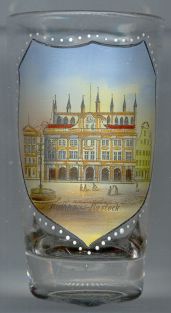
The top left picture on glass no. 3733 [left] shows a view of
The
The bottom right picture shows another view of the Kröpelin Gate (see above).
The
The
The  Rathaus (town hall) [left, no. 2473, and right, no. 1461]
was built in 1270–1290. During the Middle Ages the ground floor was used as a trading hall, while the upper parts were used
for the town administration. In 1484 the so-called "Neues Haus" (new house) was added and the façade was extended to combine
both buildings. The Baroque front part of the building was added in the early 18th century. After some modern additions in the early 20th century
a thorough renovation of the building was completed in 2002.
Rathaus (town hall) [left, no. 2473, and right, no. 1461]
was built in 1270–1290. During the Middle Ages the ground floor was used as a trading hall, while the upper parts were used
for the town administration. In 1484 the so-called "Neues Haus" (new house) was added and the façade was extended to combine
both buildings. The Baroque front part of the building was added in the early 18th century. After some modern additions in the early 20th century
a thorough renovation of the building was completed in 2002.
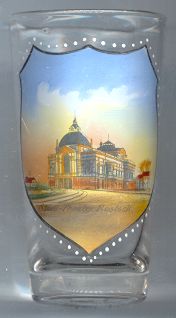
The old  Stadttheater (municipal theatre) [left, no. 1462]
was built in 1894–1895 by the architect Heinrich Seeling. The building was destroyed during the bomb raids in 1942.
Stadttheater (municipal theatre) [left, no. 1462]
was built in 1894–1895 by the architect Heinrich Seeling. The building was destroyed during the bomb raids in 1942.
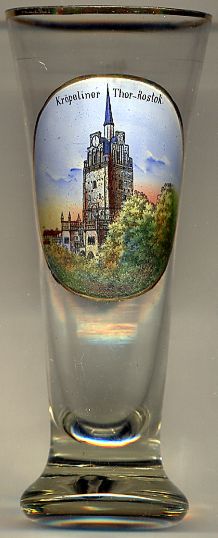
The  Kröpeliner Tor [left, no. 2474]
is the westernmost of the four large town gates of Rostock's historic fortifications. The gate was built around 1270 in Gothic style.
Even at then it was unusually tall as it already had two storeys at that time. It is uncertain whether the gate was named after the
town of Kröpelin, about 25 km west of Rostock, or whether it got its name from a patrician family. In 1500 the gate was heightened
by the addition of another 5 storeys and thus it reached a height of 54 metres.
In 1847 a neo-gothic front building was added which is also depicted on glass no. 2474. Luckily, the gate suffered only minor damages during the bomb raids of 1942.
Out of aesthetical considerations, the neo-gothic additions were removed in 1945. After a restoration, which was carried out between 1966 and 1969,
the gate building became the home of the Rostock Museum of municipal history. The museum was closed in 2004. Today the building
is used by the historical association 'Geschichtswerkstatt Rostock e.V.'.
Kröpeliner Tor [left, no. 2474]
is the westernmost of the four large town gates of Rostock's historic fortifications. The gate was built around 1270 in Gothic style.
Even at then it was unusually tall as it already had two storeys at that time. It is uncertain whether the gate was named after the
town of Kröpelin, about 25 km west of Rostock, or whether it got its name from a patrician family. In 1500 the gate was heightened
by the addition of another 5 storeys and thus it reached a height of 54 metres.
In 1847 a neo-gothic front building was added which is also depicted on glass no. 2474. Luckily, the gate suffered only minor damages during the bomb raids of 1942.
Out of aesthetical considerations, the neo-gothic additions were removed in 1945. After a restoration, which was carried out between 1966 and 1969,
the gate building became the home of the Rostock Museum of municipal history. The museum was closed in 2004. Today the building
is used by the historical association 'Geschichtswerkstatt Rostock e.V.'.

 Theaterplatz
Theaterplatz University [left, no. 3733: bottom left picture] was founded in 1419
and thus is the third-oldest university in Germany. It is the oldest and largest university in continental northern Europe
and the Baltic Sea area, and the 8th-oldest in Central Europe. It was the 5th university established in the Holy Roman Empire.
The univsersity's main building (depicted on glass no. 3733 was built in 1867–1870 by the architect Hermann
Willebrand.
University [left, no. 3733: bottom left picture] was founded in 1419
and thus is the third-oldest university in Germany. It is the oldest and largest university in continental northern Europe
and the Baltic Sea area, and the 8th-oldest in Central Europe. It was the 5th university established in the Holy Roman Empire.
The univsersity's main building (depicted on glass no. 3733 was built in 1867–1870 by the architect Hermann
Willebrand.
[https://en.wikipedia.org/wiki/University_of_Rostock;
https://de.wikipedia.org/wiki/Hauptgebäude_der_Universität_Rostock]
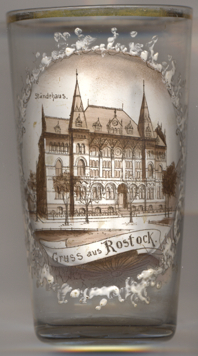
 Ständehaus ('Estates House') [near left, no. 3707] was built
in 1889–1893 in Historistic style by the architect Gotthilf Ludwig Möckel from Schwerin.
It was used as a parliament building by the Mecklenburg estates. Following the November Revulation in 1918, the estates were
dissolved and the building served diverse public purposes. During the period of the German Democratic Republic it was used
as clubhouse for the Volksmarine, the GDR naval force. Since 1992 it is the seat of the Oberlandesgericht Rostock
(Rostock Court of Appeal).
Ständehaus ('Estates House') [near left, no. 3707] was built
in 1889–1893 in Historistic style by the architect Gotthilf Ludwig Möckel from Schwerin.
It was used as a parliament building by the Mecklenburg estates. Following the November Revulation in 1918, the estates were
dissolved and the building served diverse public purposes. During the period of the German Democratic Republic it was used
as clubhouse for the Volksmarine, the GDR naval force. Since 1992 it is the seat of the Oberlandesgericht Rostock
(Rostock Court of Appeal).
[https://de.wikipedia.org/wiki/Wallstraße_(Rostock),
https://de.wikipedia.org/wiki/Oberlandesgericht_Rostock]
Warnemünde
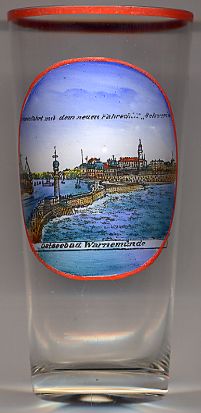 Warnemünde (in German meaning 'Warnow mouth') is a sea resort and the northmost district of Rostock, situated on the Baltic Sea at the estuary of the river Warnow.
Founded in about 1200, Warnemünde was for centuries a mere fishing village with minor importance for the economic and cultural development of the region. In 1323 Warnemünde
lost its autonomous status as it was purchased by the city of Rostock in order to safeguard the city’s access to the Baltic Sea. It was not until the 19th century that
Warnemünde began to develop into an important sea resort. Today Warnemünde has approximately 8,400 inhabitants.
Warnemünde (in German meaning 'Warnow mouth') is a sea resort and the northmost district of Rostock, situated on the Baltic Sea at the estuary of the river Warnow.
Founded in about 1200, Warnemünde was for centuries a mere fishing village with minor importance for the economic and cultural development of the region. In 1323 Warnemünde
lost its autonomous status as it was purchased by the city of Rostock in order to safeguard the city’s access to the Baltic Sea. It was not until the 19th century that
Warnemünde began to develop into an important sea resort. Today Warnemünde has approximately 8,400 inhabitants.
[Text adapted from http://en.wikipedia.org/wiki/Warnemünde]
 ferry "Schwerin" [far left, barely visible] was commissioned in 1926 and operated on the route from
Warnemünde to Gedser, Denmark. It was frequently advertised as "the White Swan of the Baltic Sea". Spacious lounges, restaurants and a promenade deck for passengers made
the trip especially enjoyable. At the beginning of World War II the "Schwerin" was used by the German Navy for a short period of time before it returned to its
comemrcial service. During the occupation of Denmark by the Wehrmacht, parts of the invasion troops were transported by the "Schwerin". With the occupation of Rostock
and Warnemünde by Soviet troops of the ferry service was discontinued. After the ferry service was resumed in 1947 by the Deutsche Reichsbahn, it was at first tried
to reactivate the "Schwerin", but the plans were abandoned.
ferry "Schwerin" [far left, barely visible] was commissioned in 1926 and operated on the route from
Warnemünde to Gedser, Denmark. It was frequently advertised as "the White Swan of the Baltic Sea". Spacious lounges, restaurants and a promenade deck for passengers made
the trip especially enjoyable. At the beginning of World War II the "Schwerin" was used by the German Navy for a short period of time before it returned to its
comemrcial service. During the occupation of Denmark by the Wehrmacht, parts of the invasion troops were transported by the "Schwerin". With the occupation of Rostock
and Warnemünde by Soviet troops of the ferry service was discontinued. After the ferry service was resumed in 1947 by the Deutsche Reichsbahn, it was at first tried
to reactivate the "Schwerin", but the plans were abandoned.
Several glasses of this collection show other ships.
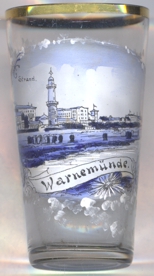 The
The  Warnemünde Lighthouse [left]
is situated on the estuary of the Warnow river.
In 1862 it was decided to replace the old 8-metre-high stormlamp in Warnemünde with a new lighthouse. The construction
of the lighthouse was officially approved in 1863, however, as a result of serious disagreement between its financiers,
the town of Rostock, the district administrator (estates of the country: parliament of patricians and knights) and the
Mecklenburg railways (the latter had owned the ferry boat route to Gedser in Denmark since 1886), the project did not
actually start until 1897. It was commissioned one year later in October 1898. The lighthouse has a height of 36.9 metres.
The lighthouse can be climbed by a granite spiral staircase. Until 1978 the lighthouse was run by a lighthouse keeper.
Now the service has been centralized and is managed by the Sea Traffic Control Centre at Hohe Düne.
Warnemünde Lighthouse [left]
is situated on the estuary of the Warnow river.
In 1862 it was decided to replace the old 8-metre-high stormlamp in Warnemünde with a new lighthouse. The construction
of the lighthouse was officially approved in 1863, however, as a result of serious disagreement between its financiers,
the town of Rostock, the district administrator (estates of the country: parliament of patricians and knights) and the
Mecklenburg railways (the latter had owned the ferry boat route to Gedser in Denmark since 1886), the project did not
actually start until 1897. It was commissioned one year later in October 1898. The lighthouse has a height of 36.9 metres.
The lighthouse can be climbed by a granite spiral staircase. Until 1978 the lighthouse was run by a lighthouse keeper.
Now the service has been centralized and is managed by the Sea Traffic Control Centre at Hohe Düne.
![[scale]](lineal.jpg)